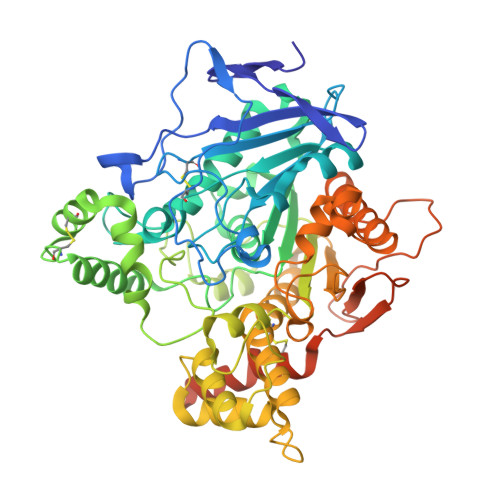Increasing Polarity in Tacrine and Huprine Derivatives: Potent Anticholinesterase Agents for the Treatment of Myasthenia Gravis.
Galdeano, C., Coquelle, N., Cieslikiewicz-Bouet, M., Bartolini, M., Perez, B., Clos, M.V., Silman, I., Jean, L., Colletier, J.P., Renard, P.Y., Munoz-Torrero, D.(2018) Molecules 23
- PubMed: 29534488
- DOI: https://doi.org/10.3390/molecules23030634
- Primary Citation of Related Structures:
6G1U, 6G1V, 6G1W - PubMed Abstract:
Symptomatic treatment of myasthenia gravis is based on the use of peripherally-acting acetylcholinesterase (AChE) inhibitors that, in some cases, must be discontinued due to the occurrence of a number of side-effects. Thus, new AChE inhibitors are being developed and investigated for their potential use against this disease. Here, we have explored two alternative approaches to get access to peripherally-acting AChE inhibitors as new agents against myasthenia gravis, by structural modification of the brain permeable anti-Alzheimer AChE inhibitors tacrine, 6-chlorotacrine, and huprine Y. Both quaternization upon methylation of the quinoline nitrogen atom, and tethering of a triazole ring, with, in some cases, the additional incorporation of a polyphenol-like moiety, result in more polar compounds with higher inhibitory activity against human AChE (up to 190-fold) and butyrylcholinesterase (up to 40-fold) than pyridostigmine, the standard drug for symptomatic treatment of myasthenia gravis. The novel compounds are furthermore devoid of brain permeability, thereby emerging as interesting leads against myasthenia gravis.
Organizational Affiliation:
Laboratory of Pharmaceutical Chemistry (CSIC Associated Unit), Faculty of Pharmacy and Food Sciences, and Institute of Biomedicine (IBUB), University of Barcelona, Av. Joan XXIII 27-31, E-08028 Barcelona, Spain. cgaldeano@ub.edu.


















